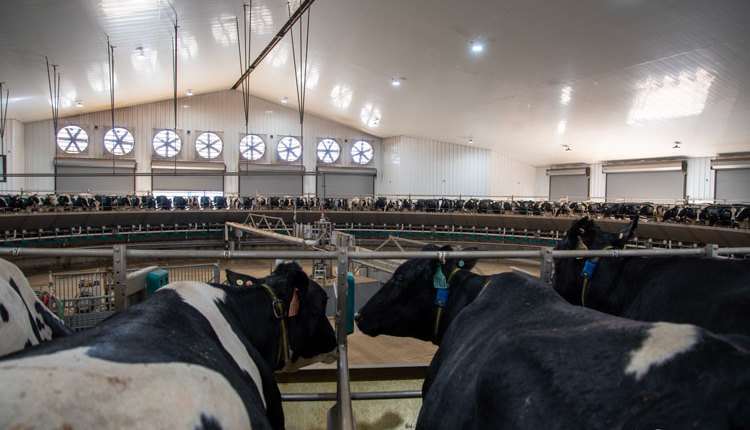
The author is a veterinarian who runs UdderWise-Global Mastitis Solutions, United Kingdom. To learn more about the author, visit his website at www.udderwise.co.uk.
Selective dry cow therapy targets only cows that have or had infections to receive antibiotics at dry-off. At the same time, cows that do not receive antibiotics get an internal teat seal. This strategy is being encouraged because dry cow therapy accounts for about 40 percent of all antibiotic use in dairy cows. To many farmers it’s a major change, and switching mindsets can be challenging as individuals, quite understandably, are worried about change and subsequent milk quality going awry.
Paul made the change to selective dry cow therapy. Admittedly, it took time before he was comfortable enough to start but it has proven very successful. He milks 400 Holstein cows in Somerset, located in southwest England. The herd’s somatic cell count runs between 100,000 and 125,000, and there are fewer than 20 cases of mastitis per 100 cows per year. Mastitis and milk quality are not a problem.
Paul took over running the dairy from his dad a couple of years ago. He was understandably apprehensive about changing from blanket dry cow therapy. He didn’t want things to go wrong and, more importantly, he wanted to make sure he wouldn’t let his dad down.
Over a period of three months we had various discussions; the benefits of changing and the risks of things going wrong. We agreed to start off using low thresholds so that a relatively small proportion of cows didn’t get antibiotics at dry-off. Once he was confident that it was working well, and there were no changes to cell count or clinical mastitis, we started to raise the thresholds.
We made a list
Paul and I sat down recently to discuss the progress and go through the benefits. Here’s our list.
- Reducing the risk of antibiotic resistance is important to Paul. He has three young kids and his grandparents are in their 80s. He knows how important antibiotics are in the event of illness. He was also keen to reduce the risk of resistance when treating his own animals.
- He makes better use of records as he has to select which cows can receive antibiotics. This did not really happen when he was using blanket dry cow therapy. Paul finds that looking through the clinical mastitis and individual cow cell count data is really useful and has identified several problem cows for culling.
- Milk from cows that calve early that only had an internal teat seal can go into the tank. That is a real relief if cows calved to an earlier service. That caused milk to be dumped if the milk withdrawal period with dry cow therapy had not passed.
- Paul was one of the first farmers to start using an internal teat seal at dry-off about 10 years ago. He understood that many teats are open throughout the dry period; that environmental bacteria enter the udder at this time and cause clinical mastitis in the next lactation. Paul noticed a reduction in the number of toxic cases of mastitis once he started using an internal teat seal at dry-off and clinical mastitis levels dropped by 25 percent.
- Paul pointed out that a herd that has not used an internal teat seal will see additional benefits. Clinical mastitis levels will drop by an average of 25 percent, which will reduce the number of antibiotics treatments during lactation. There is also less time spent treating clinical cases in the parlor.
- Meticulous hygiene at dry-off is essential. Jane, Paul’s wife, has stressed that this should be treated like a surgical operation. They use cotton wool balls soaked in surgical spirits (alcohol) to clean the teat ends before infusing any intramammary tube. If teat prep before infusion is meticulous, then the risk of introducing any infection will be minimal.
- Recent research has shown that when antibiotic dry cow therapy has been given to low cell count cows, there is an elevated risk of E. coli mastitis.
- Infusing just one tube rather than two saves time and reduces the risk of introducing infection through the teat canal. Time is one of the things that farmers like Paul are always short on.
- There is likely to be a benefit to calf health as newborns will not ingest traces of antibiotics from the colostrum. Oral antibiotics affect the gut bacterial flora and this doesn’t help the baby calf.
- Finally, there is a cost savings. For most herds that are already using blanket dry cow therapy and an internal teat sealant, they are likely to reduce dry cow therapy use by about 50 percent. This could pay for a herd vaccination against a disease like leptospirosis. For the herds that have just been using dry cow therapy, there is the additional cost of teat sealant, but there will also be a significant overall savings from a reduction in subsequent clinical mastitis.
Valuing customers
The last thing that Paul said was that this is just the right thing to do; we owe it to our consumers. We have to be responsible as we are producing wholesome food for our children and families.








